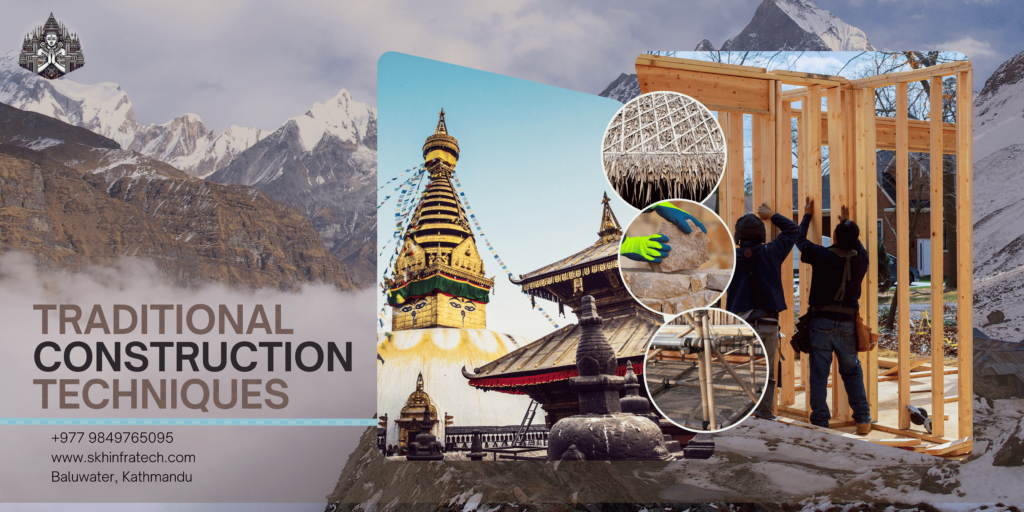Table of Contents
Introduction
Traditional construction techniques, rich in cultural history and environmental wisdom, reveal how societies have smartly utilised available resources to create enduring and sustainable structures. These methods, which are still relevant today, offer practical solutions for contemporary architectural challenges. In this blog, we delve into various traditional building techniques from around the world and examine their timeless benefits.
Traditional Building Methods from Around the World
-
Adobe Construction
Materials: Sun-dried mud bricks (adobes), straw
Regions: Middle East, parts of Africa, Latin America
Techniques: Adobe bricks are crafted by mixing mud and straw, shaped into molds, and dried in the sun. These bricks are then stacked and bonded with more mud to build walls.
Advantages: Excellent thermal mass, environmentally friendly, cost-effective.
-
Cob Construction
Materials: Subsoil, water, fibrous organic material (straw)
Regions: England, parts of Europe, Africa
Techniques: A mixture of subsoil, water, and straw is kneaded and then sculpted into walls by hand. The walls are often quite thick, providing good insulation.
Advantages: Strong, durable, and flexible design.
-
Timber Framing
Materials: Wood (logs or hewn timbers), joinery techniques
Regions: Europe, Asia (notably Japan), North America
Techniques: Heavy timbers are joined using various woodworking joints (mortise and tenon, dovetails) without nails or screws. The framework is then infilled with various materials (wattle and daub, brick).
Advantages: Strong structural integrity, aesthetic appeal, and flexibility in design.
-
Stone Masonry
Materials: Natural stones, mortar (sometimes dry-stone without mortar)
Regions: Europe (notably Mediterranean), Middle East, South Asia
Techniques: Stones are shaped and laid in courses, with or without mortar. Dry-stone techniques rely on precise placement and gravity.
Advantages: Extremely durable, fire-resistant, and provides excellent thermal mass.
-
Wattle and Daub
Materials: Woven wooden lattice (wattle), covered with a mixture of mud, clay, sand, animal dung, and straw (daub)
Regions: Europe, Africa, South America
Techniques: The wattle framework is created by weaving branches or sticks, which is then covered with the daub mixture to form walls.
Advantages: Insulating, flexible, and uses locally available materials.
-
Thatch Roofing
Materials: Dry vegetation (reeds, straw, palm fronds)
Regions: Europe, Africa, Southeast Asia
Techniques: Bundles of vegetation are laid in overlapping layers and secured to the roof structure.
Advantages: Good insulation, water-resistant, and environmentally friendly. Rammed Earth
-
Rammed Earth
Materials: Soil, gravel, stabilizers (lime or cement in some cases)
Regions: China, Africa, parts of Europe and America
Techniques: Earth is compacted into formwork to create dense, strong walls.
Advantages: Thermal mass, durability, and low environmental impact.
-
Bamboo Construction
Materials: Bamboo poles
Regions: Southeast Asia, South America
Techniques: Bamboo is cut, treated, and used for structural elements, walls, and roofs. Joinery can involve tying, pegging, or lashing.
Advantages: Sustainable, lightweight, strong, and flexible.
-
Log Building
Materials: Logs
Regions: North America, Scandinavia, Russia
Techniques: Logs are notched at the ends and stacked horizontally to form walls. The gaps between logs are filled with insulating materials like moss or modern chinking.
Advantages: Naturally insulating, strong, and aesthetically pleasing.
-
Earthen Plasters and Finishes
Materials: Clay, sand, straw
Regions: Various regions globally
Techniques: Mixtures of clay, sand, and straw are applied to walls to create smooth, durable finishes. Often used in conjunction with adobe or cob construction.
Advantages: Breathable, environmentally friendly, and provides a natural aesthetic.
Advantages of Traditional Construction Techniques
Sustainability and Environmental Friendliness
Traditional methods often use locally sourced materials, reducing transportation emissions and resource depletion. The minimal processing required for these materials leads to lower energy consumption, and their biodegradability ensures a reduced long-term environmental impact.
Thermal Efficiency
Many traditional techniques, such as adobe and cob, offer excellent natural insulation and thermal mass. This efficiency helps maintain comfortable indoor temperatures and reduces the need for artificial heating and cooling, resulting in energy savings.
Cultural and Historical Preservation
These building methods preserve cultural heritage and architectural identity, maintaining historical significance and supporting local craftsmanship.
Economic Benefits
Traditional construction can be cost-effective, especially in areas where materials are locally available. It also creates employment opportunities and supports local economies by engaging local craftsmen and artisans.
Durability and Resilience
Traditional buildings are often well-adapted to local conditions, offering resilience against natural disasters and demonstrating longevity.
Health and Wellbeing
Using non-toxic, natural materials promotes healthier indoor air quality. The unique aesthetics of traditional buildings also enhance the visual appeal and cultural value of an area, contributing to a sense of wellbeing.
Flexibility and Adaptability
Customizable: Traditional techniques allow for a high degree of customization and creativity in design, accommodating specific needs and preferences.
Repair and Maintenance: Traditional buildings can often be repaired and maintained using local materials and skills, making them easier and less costly to upkeep.
Resource Efficiency
Waste Minimization: Traditional construction often results in less waste compared to modern methods, as materials are used efficiently and excess can be repurposed.
Water Conservation: Techniques like adobe and rammed earth construction use minimal water compared to modern concrete.
Traditional Construction Materials
Traditional construction materials are diverse and reflect the local resources and environmental conditions of the regions where they are used. Here are some key traditional construction materials:
-
Adobe
Description: Sun-dried mud bricks mixed with straw.
Uses: Walls and structures in arid regions.
-
Cob
Description: A mixture of subsoil, water, straw, and sometimes lime.
Uses: Sculpted walls and buildings.
-
Timber
Description: Wood from trees, either logs or hewn timbers.
Uses: Framing, structural elements, and cladding.
-
Stone
Description: Natural stones, sometimes used with mortar.
Uses: Walls, foundations, and decorative elements.
-
Wattle and Daub
Description: Woven wooden lattice (wattle) covered with a mixture of mud, clay, sand, and straw (daub).
Uses: Wall construction.
-
Thatch
Description: Dry vegetation such as reeds, straw, or palm fronds.
Uses: Roofing material.
-
Rammed Earth
Description: Compacted soil, sometimes stabilized with lime or cement.
Uses: Walls and foundations.
-
Bamboo
Description: Fast-growing, renewable grass.
Uses: Structural elements, walls, and roofing.
-
Logs
Description: Whole tree trunks or large branches.
Uses: Wall construction, particularly in log cabins.
-
Earthen Plasters
Description: Mixtures of clay, sand, and straw.
Uses: Finishing walls and surfaces.
Traditional vs Modern Construction Techniques
-
Materials
Traditional: Uses locally sourced, natural materials such as adobe, cob, timber, stone, thatch, bamboo, and rammed earth.
Modern: Utilizes industrially produced materials like concrete, steel, glass, and synthetic composites.
-
Sustainability
Traditional: Generally more sustainable due to the use of natural, renewable, and biodegradable materials with low energy consumption in processing.
Modern: Often less sustainable due to high energy consumption in manufacturing and transportation of materials; however, modern green building practices aim to improve this.
-
Construction Methods
Traditional: Manual techniques involving craftsmanship, such as stone masonry, timber framing, and wattle and daub.
Modern: Mechanized and standardized methods using advanced machinery, prefabrication, and automated processes.
-
Design and Aesthetics
Traditional: Reflects local cultural and historical influences, often resulting in unique and region-specific architecture.
Modern: Focuses on functionality, efficiency, and often a minimalist aesthetic; global styles can be more uniform and less reflective of local culture.
-
Thermal Efficiency
Traditional: Natural insulation properties and thermal mass (e.g., thick adobe or cob walls) provide excellent temperature regulation.
Modern: Relies on insulation materials and HVAC systems to manage temperature, which can be highly effective but energy-intensive.
-
Durability and Maintenance
Traditional: Many traditional buildings have proven durable over centuries but may require regular maintenance using specific skills and materials.
Modern: Modern materials like reinforced concrete and steel can offer high durability and low maintenance, but some newer materials may not have long-term performance data.
-
Cost
Traditional: Can be cost-effective, especially in areas where materials are locally available and labor costs are lower.
Modern: Often higher initial costs due to industrial materials and machinery, though economies of scale can reduce costs in large projects.
-
Environmental Impact
Traditional: Lower environmental impact due to the use of natural materials and less energy-intensive processes.
Modern: Higher environmental impact due to the energy and resources required for material production and construction, though modern techniques increasingly incorporate sustainability practices.
-
Health and Wellbeing
Traditional: Natural materials promote better indoor air quality and a healthier living environment.
Modern: Can achieve healthy environments with proper ventilation systems and low-VOC (volatile organic compounds) materials, but synthetic materials can sometimes pose health risks.
-
Flexibility and Adaptability
Traditional: Customizable and adaptable to local conditions and needs, though sometimes limited by the availability of traditional skills and materials.
Modern: Highly flexible with the ability to create complex structures and large-scale buildings, often with the integration of smart technologies.
FAQs
1. What are the main differences between traditional and modern construction techniques?
Traditional construction techniques use natural, locally sourced materials and manual craftsmanship, while modern methods rely on industrially produced materials and mechanized, standardized processes. Traditional techniques are often more sustainable and culturally integrated, whereas modern methods offer greater durability, efficiency, and flexibility.
2. Are traditional construction techniques still relevant today?
Yes, traditional construction techniques are still relevant, especially in regions where local materials are abundant and cost-effective. They also offer sustainable and environmentally friendly building options, preserve cultural heritage, and can be adapted to modern needs.
3. Can traditional and modern construction techniques be combined?
Yes, combining traditional and modern construction techniques can leverage the strengths of both. This hybrid approach can lead to innovative solutions that are sustainable, culturally respectful, and technologically advanced, enhancing overall building performance.
4. Which construction technique is more cost-effective?
The cost-effectiveness of a construction technique depends on the context. Traditional methods can be more affordable in areas with readily available local materials and skilled labor. Modern techniques can benefit from economies of scale and advanced technology, which may reduce costs in large projects.
5. How do traditional construction techniques impact environmental sustainability?
Traditional construction techniques generally have a lower environmental impact due to the use of natural, renewable, and locally sourced materials. These methods typically require less energy for material processing and construction, resulting in a smaller carbon footprint and promoting sustainability.
Conclusion
Both traditional and modern construction techniques have their own set of advantages and disadvantages. Traditional methods excel in sustainability, cultural integration, and environmental friendliness, while modern techniques offer durability, efficiency, and flexibility. Integrating the best aspects of both approaches can lead to innovative, sustainable, and culturally respectful construction solutions.



